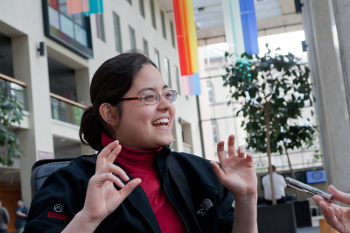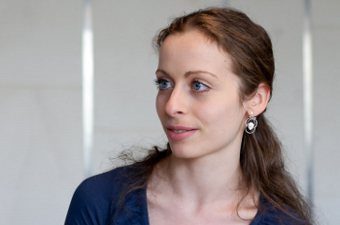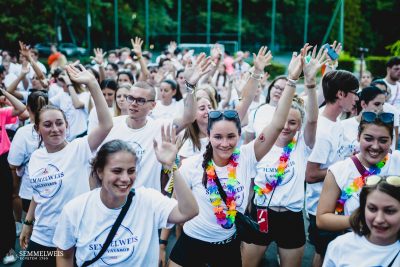Semmelweis University is a truly international community, embracing students from 64 national around the world, with foreign students accounting for nearly a quarter of the total student population. Here, we introduce two of the most talented international students: Leesa Parkison from Japan and Matilde Sassani from Italy.
Leesa Parkison
Japan-born medical student Leesa Parkison first heard about Semmelweis University in a newspaper article during her final year of high school. She initially pursued her studies in environmental sciences but, once she realised her true calling was medicine, Leesa applied to Semmelweis.
She left Japan shortly after the massive 2011 earthquake. “I was at home when it happened,” she recollected. “We usually have a lot of earthquakes, so at first I just thought, ‘Oh, another earthquake.’ But, by the third shake, I realized this was much more powerful than anything I’ve experienced in my life,” she said, adding that, luckily, her area wasn’t badly affected. She watched the event unfold on television. “All channels switched to the news, so while it was still shaking, I was seeing images of the tsunami destroying everything,” she recalled.
Just finishing up her first year, Leesa is very satisfied with her experience so far. “It’s amazing, because we get a lot of practice even in the first year; we get to actually dissect, not just observe, and because we see lots of bodies and individual organs, we get first-hand experience of all the structures.” Coming from Japan, this is something she can appreciate: “There is a shortage of bodies in Japan, so many doctors don’t get enough practice,” she said.
 Interested in both clinical and research work, Leesa hopes to do both. Her current areas of interest are paediatrics and immunology, though she feels she still has a lot to explore. Although not involved in the Ödön-Kerpel Talent Support Programme, Leesa is an exemplary part of Semmelweis Univeristy.
Interested in both clinical and research work, Leesa hopes to do both. Her current areas of interest are paediatrics and immunology, though she feels she still has a lot to explore. Although not involved in the Ödön-Kerpel Talent Support Programme, Leesa is an exemplary part of Semmelweis Univeristy.
Aside from Japan, Leesa has also spent time in the U.S.; yet, it is in Hungary where she feels almost the most at home. “It’s really weird, because it’s the first time I’ve come here,” she said. “Hungary is a nice balance of Japan and the U.S.; I don’t miss too much of either, because enough of both is incorporated here.”
Leesa has met lots of people in Hungary, perhaps because so many come to her assistance when they see her trying to open a door in her wheelchair. “I’ve been in a wheelchair for around four years now,” she says. “I feel very independent here; it’s very easy to get around Budapest.”
“I can only do what I’m doing now because of all the kindness and support of those around me, which I sincerely appreciate,” she said, adding that it’s important to never give up: “I don’t want to be confined to a wheelchair for the rest of my life, I’m very hopeful about improving.”
Matilde Sassani
Matilde Sassani, a 2nd year medical student, grew up in the Italian cities of Rome, Perugia and Milan. Not your typical medical student, Matilde is also a professional ballet dancer. She studied at La Scala Theatre Ballet School in Milan and the English National Ballet School in London, and has also danced with the Zurich Ballet Company. It was also her passion for ballet which brought her to Hungary, first starting her life here as a dancer with the Hungarian National Ballet Company.

The daughter of a nuclear physicist and a neuropsychiatrist, Matilde had long known she wanted to pursue the scientific line in addition to the performing arts. It was, in part, an admiration for her mother’s ability to help others, which inspired Matilde to enter the medical field. She chose to pursue her studies at Semmelweis University partly for practical reasons, as she was already living in Budapest at the time. However, it was the University’s international renown, practice-oriented teaching and multicultural environment which ultimately decided her choice.
Although she continues to pursue dancing as a hobby, Matilde has put her career in ballet on hold in order to be able to fully concentrate on her medical studies. “University is full time work, it’s not possible to do both. From the second year, my schedule became very busy and classes overlapped with ballet practice, so I had to make a choice,” she explained.
The decision to drop ballet in order to focus on academics has certainly not been made in vain, as Matilde is one of just two international students to be enrolled in the prestigious Ödön Kerpel-Fronius Talent Support Programme for exceptional students. As part of the programme, Matilde has been assigned a personal mentor who will guide her in academic and life decisions.
After four years in Hungary, Matilde feels at home. “I have a Hungarian boyfriend and lots of friends,” she said, adding that her favourite place in Budapest is still the Opera House, because of all the good memories of the time spent there as a ballet dancer.
Pálma Dobozi and Gina Varga-Gönczi


